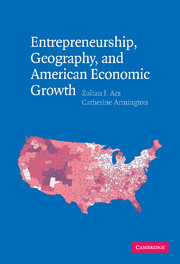Book contents
- Frontmatter
- Contents
- List of Tables and Figures
- Preface
- 1 Introduction
- 2 Entrepreneurship, Geography, and Growth
- 3 Regional Variation in Entrepreneurial Activity
- 4 Human Capital and Entrepreneurship
- 5 Entrepreneurship and Employment Growth
- 6 Summary and Theoretical Insights
- 7 A Formulation of Entrepreneurship Policy
- Appendix A: Firm Formation and Growth Data from the Longitudinal Establishment and Enterprise Microdata (LEEM)
- Appendix B: 1995 + 1996 Firm Formation Rates for U.S. Labor Market Areas with 1994 Labor Force and Establishments
- Appendix C: Service Industry Standard Industrial Classification (4-digit SIC) Codes and Their Subsectors, with 1995 Establishment and Employment and Changes to 1998, and 1996 through 1998 Firm Formations per 100 Establishments in Subsector in 1995
- Appendix D: 1991–1996 Employment Growth Rates and Share of High-Growth Establishments in Labor Market Areas, with 1991 Employment, Establishments, and Population, and 1991–1996 Population Growth and Relative Employment Growth Rates
- References
- Index
5 - Entrepreneurship and Employment Growth
Published online by Cambridge University Press: 31 July 2009
- Frontmatter
- Contents
- List of Tables and Figures
- Preface
- 1 Introduction
- 2 Entrepreneurship, Geography, and Growth
- 3 Regional Variation in Entrepreneurial Activity
- 4 Human Capital and Entrepreneurship
- 5 Entrepreneurship and Employment Growth
- 6 Summary and Theoretical Insights
- 7 A Formulation of Entrepreneurship Policy
- Appendix A: Firm Formation and Growth Data from the Longitudinal Establishment and Enterprise Microdata (LEEM)
- Appendix B: 1995 + 1996 Firm Formation Rates for U.S. Labor Market Areas with 1994 Labor Force and Establishments
- Appendix C: Service Industry Standard Industrial Classification (4-digit SIC) Codes and Their Subsectors, with 1995 Establishment and Employment and Changes to 1998, and 1996 through 1998 Firm Formations per 100 Establishments in Subsector in 1995
- Appendix D: 1991–1996 Employment Growth Rates and Share of High-Growth Establishments in Labor Market Areas, with 1991 Employment, Establishments, and Population, and 1991–1996 Population Growth and Relative Employment Growth Rates
- References
- Index
Summary
Introduction
As we showed in Chapter Two, neoclassical growth theory had no mechanism to explain the relationship between entrepreneurial activity and economic growth (Solow, 1956). Because scale economies operate at the establishment level, in the traditional Solow model economic growth relied on physical capital investment in larger establishments. However, capital accumulation can explain only a small amount of the variation in economic growth across regions (Ciccone and Hall, 1996).
Recent theories of economic growth focus on the importance of knowledge and view knowledge externalities, as opposed to scale economies, as the primary engine of economic growth (Romer, 1986). This suggests that if the domestic economy is endogenously growing, and if we believe in competitive markets, then knowledge spillovers must feature in the economic landscape. This concept of spillovers solves the technical problem in economic theory of reconciling increasing returns (which are generally needed to generate endogenous growth) with competitive markets.
The concept of knowledge spillovers leads to several theoretical issues. First, a large body of recently emerged literature has been studying the spatial extent of knowledge spillovers with particular attention to spillovers from industrial and academic research. At different levels of spatial aggregation (such as states, metropolitan areas, counties) in different countries (e.g., the United States, France, Germany, Italy, Austria), and with the application of different econometric methodologies (e.g., various spatial or aspatial methods), many of these studies conclude that geographical proximity to the knowledge source significantly amplifies spillovers between research and innovating firms.
- Type
- Chapter
- Information
- Entrepreneurship, Geography, and American Economic Growth , pp. 108 - 142Publisher: Cambridge University PressPrint publication year: 2006



